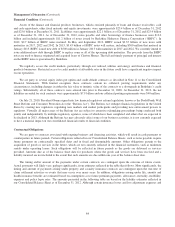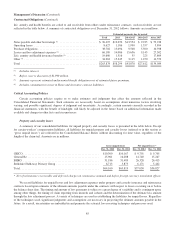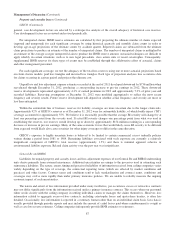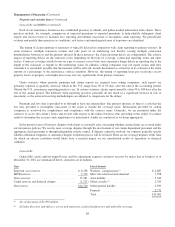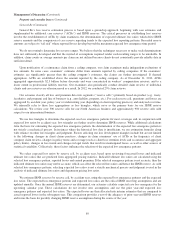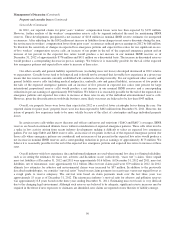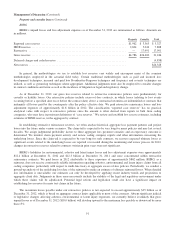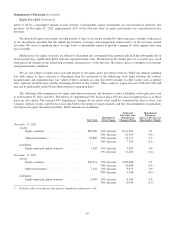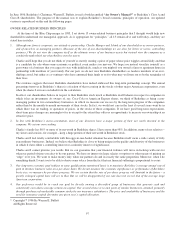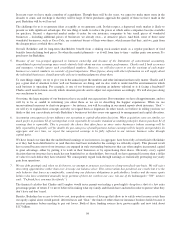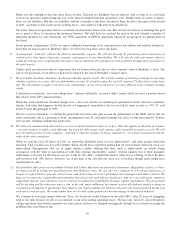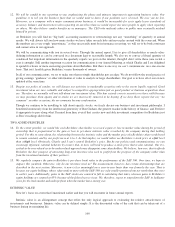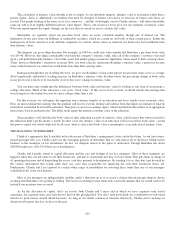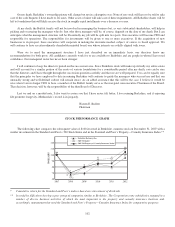Berkshire Hathaway 2012 Annual Report Download - page 94
Download and view the complete annual report
Please find page 94 of the 2012 Berkshire Hathaway annual report below. You can navigate through the pages in the report by either clicking on the pages listed below, or by using the keyword search tool below to find specific information within the annual report.Management’s Discussion (Continued)
Property and casualty losses (Continued)
BHRG (Continued)
A significant number of our reinsurance contracts are expected to have a low frequency of claim occurrence combined with
a potential for high severity of claims. These include property losses from catastrophes and aviation risks under catastrophe and
individual risk contracts. Loss reserves related to catastrophe and individual risk contracts were approximately $1.6 billion at
December 31, 2012, a decrease of about $400 million from December 31, 2011. In 2012, changes in estimated losses for prior
years’ events had an insignificant effect on pre-tax earnings. Reserving techniques for catastrophe and individual risk contracts
generally rely more on a per-policy assessment of the ultimate cost associated with the individual loss event rather than with an
analysis of the historical development patterns of past losses. Catastrophe loss reserves are provided when it is probable that an
insured loss has occurred and the amount can be reasonably estimated. Absent litigation affecting the interpretation of coverage
terms, the expected claim-tail is relatively short and thus the estimation error in the initial reserve estimates usually emerges
within 24 months after the loss event.
Other reinsurance reserve amounts are generally based upon loss estimates reported by ceding companies and IBNR
reserves that are primarily a function of reported losses from ceding companies and anticipated loss ratios established on an
individual contract basis, supplemented by management’s judgment of the impact on each contract of major catastrophe events
as they become known. Anticipated loss ratios are based upon management’s judgment considering the type of business
covered, analysis of each ceding company’s loss history and evaluation of that portion of the underlying contracts underwritten
by each ceding company, which are in turn ceded to BHRG. A range of reserve amounts as a result of changes in underlying
assumptions is not prepared.
Derivative contract liabilities
Our Consolidated Balance Sheets include significant amounts of derivative contract liabilities that are measured at fair
value. As of December 31, 2012 our most significant derivative contract exposures relate to equity index put option contracts
written between 2004 and 2008. These contracts were entered into in over-the-counter markets and certain elements in the terms
and conditions of such contracts are not standard. In particular, we are not required to post collateral under most of our
contracts. Furthermore, there is no source of independent data available to us showing trading volume and actual prices of
completed transactions. As a result, the values of these liabilities are based on valuation models that are believed to be used by
market participants. Such models or other valuation techniques may use inputs that are observable in the marketplace, while
others are unobservable. Unobservable inputs require us to make certain projections and assumptions about the information that
would be used by market participants in establishing prices. Changes in assumptions may have a significant effect on values.
We determine the estimated fair value of equity index put option contracts using a Black-Scholes based option valuation
model. Inputs to the model include the current index value, strike price, interest rate, dividend rate and contract expiration date.
The weighted average interest and dividend rates used as of December 31, 2012 were 2.1% and 3.3%, respectively, and were
approximately 3.3% and 3.0%, respectively, as of December 31, 2011. The interest rates as of December 31, 2012 and 2011
were approximately 95 basis points and 153 basis points (on a weighted average basis), respectively, over benchmark interest
rates and represented our estimate of our nonperformance risk. We believe, however, that the most significant economic risks
under these contracts relate to changes in the index value component and to a lesser degree to the foreign currency component.
The Black-Scholes based model also incorporates volatility estimates that measure potential price changes over time. Our
contracts have an average remaining maturity of about 8 years. The weighted average volatility used as of December 31, 2012
was approximately 20.9%, compared to 21.4% as of December 31, 2011. The weighted average volatilities are based on the
volatility input for each equity index put option contract weighted by the notional value of each equity index put option contract
as compared to the aggregate notional value of all equity index put option contracts. The volatility input for each equity index
put option contract reflects our expectation of future price volatility. The impact on fair value as of December 31, 2012
($7.5 billion) from changes in the volatility assumption is summarized in the table that follows. The values of contracts in an
92




